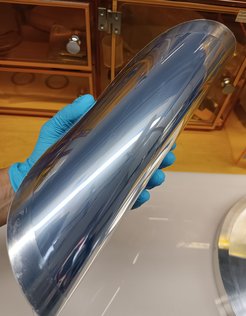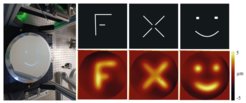New membrane mirrors for large space-based telescopes
Lightweight flexible mirrors could be rolled up during launch and precisely reshaped after deployment
Researchers at the Max Planck Institute for Extraterrestrial Physics have developed a new way to produce and shape large, high-quality mirrors that are much thinner than conventional mirrors used for space telescopes. The resulting mirrors are flexible enough to be rolled up and stored compactly inside a launch vehicle.

“Launching and deploying space telescopes is a complicated and costly procedure,” says Sebastian Rabien from the MPE. “This new approach — which is very different from typical mirror production and polishing procedures — could help solve weight and packaging issues for telescope mirrors.” This would enable much larger, and thus more sensitive telescopes to be placed in orbit.
The new method was developed during the COVID-19 pandemic, which Rabien says gave him some extra time to think and try out new concepts. The new technique: mirrors are grown by chemical vapor deposition on a rotating liquid inside a vacuum chamber. While this work demonstrated the feasibility of the method, with the successful fabrication of parabolic membrane mirror prototypes up to 30 cm in diameter, “it lays the groundwork for larger packable mirror systems that are less expensive than usual,” adds Rabien.
For the deposition, monomeric molecules are created that deposit on the surfaces in a vacuum chamber and combine to form a polymer. Commonly used to apply coatings e.g. to make electronics water-resistant, this is the first time, that the process has been used to create parabolic membrane mirrors with the optical qualities necessary for use in telescopes. The crucial step: a rotating container filled with a small amount of liquid, which forms a perfect parabolic shape – a “mold” that is affordable and can easily be scaled up to large sizes. When the polymer is thick enough, a reflective metal layer is applied to the top and the liquid is washed away.

The thin and lightweight mirror created using this technique can easily be folded or rolled up for the trip to space. However, it would be nearly impossible to get it back to the perfect parabolic shape after unpacking. The researchers therefore developed an adaptive shape control based on a localized temperature change created with spatially variable light projection..
Next, the researchers plan to apply more sophisticated adaptive control to study how well the final surface can be shaped and how much of an initial distortion can be tolerated. They also plan to create a meter-sized deposition chamber to better study the surface structure and packaging and unfolding processes for a large-scale primary mirror.













